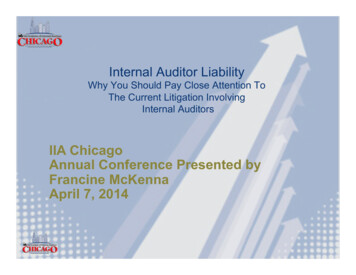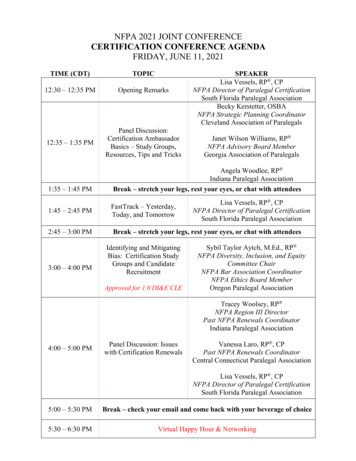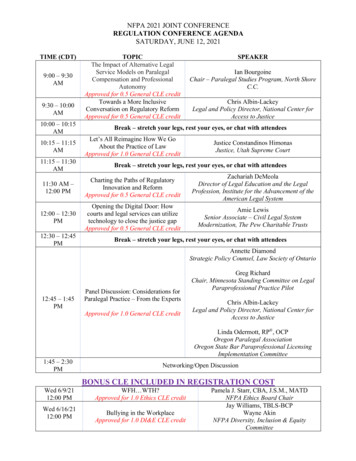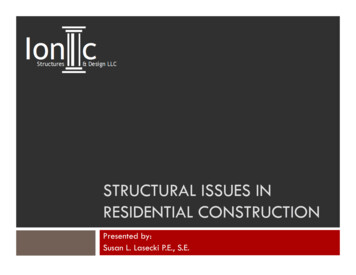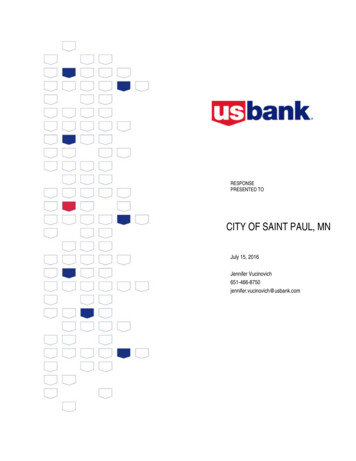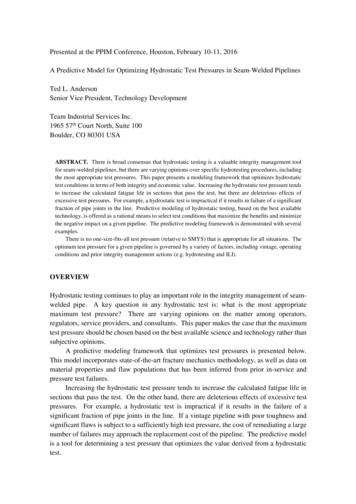
Transcription
Presented at the PPIM Conference, Houston, February 10-11, 2016A Predictive Model for Optimizing Hydrostatic Test Pressures in Seam-Welded PipelinesTed L. AndersonSenior Vice President, Technology DevelopmentTeam Industrial Services Inc.1965 57th Court North, Suite 100Boulder, CO 80301 USAABSTRACT. There is broad consensus that hydrostatic testing is a valuable integrity management toolfor seam-welded pipelines, but there are varying opinions over specific hydrotesting procedures, includingthe most appropriate test pressures. This paper presents a modeling framework that optimizes hydrostatictest conditions in terms of both integrity and economic value. Increasing the hydrostatic test pressure tendsto increase the calculated fatigue life in sections that pass the test, but there are deleterious effects ofexcessive test pressures. For example, a hydrostatic test is impractical if it results in failure of a significantfraction of pipe joints in the line. Predictive modeling of hydrostatic testing, based on the best availabletechnology, is offered as a rational means to select test conditions that maximize the benefits and minimizethe negative impact on a given pipeline. The predictive modeling framework is demonstrated with severalexamples.There is no one-size-fits-all test pressure (relative to SMYS) that is appropriate for all situations. Theoptimum test pressure for a given pipeline is governed by a variety of factors, including vintage, operatingconditions and prior integrity management actions (e.g. hydrotesting and ILI).OVERVIEWHydrostatic testing continues to play an important role in the integrity management of seamwelded pipe. A key question in any hydrostatic test is: what is the most appropriatemaximum test pressure? There are varying opinions on the matter among operators,regulators, service providers, and consultants. This paper makes the case that the maximumtest pressure should be chosen based on the best available science and technology rather thansubjective opinions.A predictive modeling framework that optimizes test pressures is presented below.This model incorporates state-of-the-art fracture mechanics methodology, as well as data onmaterial properties and flaw populations that has been inferred from prior in-service andpressure test failures.Increasing the hydrostatic test pressure tends to increase the calculated fatigue life insections that pass the test. On the other hand, there are deleterious effects of excessive testpressures. For example, a hydrostatic test is impractical if it results in the failure of asignificant fraction of pipe joints in the line. If a vintage pipeline with poor toughness andsignificant flaws is subject to a sufficiently high test pressure, the cost of remediating a largenumber of failures may approach the replacement cost of the pipeline. The predictive modelis a tool for determining a test pressure that optimizes the value derived from a hydrostatictest.
MODELING FRAMEWORKFigure 1 illustrates how hydrostatic testing is typically used to ensure integrity of pipelinessubject to in-service flaw growth. Referring to the sketch on the left, the red curvecorresponds to the critical flaw dimensions at the hydrotest pressure, which are computedfrom a fracture model. Flaws above the red curve are assumed to be eliminated by the test.The blue curve represents the critical flaw dimensions at the maximum operating pressure(MOP). A remaining life calculation can be performed to estimate the time required for aflaw on the red curve to grow to the blue curve. In the case of a seam-welded pipeline thatexperiences pressure cycling, a pressure cycle fatigue analysis (PCFA) is usually used toestimate the remaining life following a hydrostatic test.The sketch on the right side of Fig. 1 illustrates the effect of test pressure on remaininglife estimates. As test pressure increases for a given MOP, the distance between the red andblue curves increases. In other words, the starting flaw size for a fatigue analysis decreaseswith increasing test pressure, which results in a longer calculated remaining life.Based solely on conventional PCFA models, the benefits of hydrostatic tests appear toincrease with test pressure indefinitely. Reality is more complex, however. Excessively hightest pressures can damage the pipeline. An inordinate number of ruptures during ahydrostatic test can have an unacceptable economic impact. Pipe joints with strengthproperties at the lower tail of the bell curve may experience diameter swelling, which resultsin higher hoop stresses in subsequent operation. Moreover, conventional PCFA models donot account for fatigue retardation following a hydrotest, which prolongs life. The beneficialeffects of fatigue retardation can be greater at moderate test pressures, so the true life of apipeline does not necessarily increase monotonically with test pressure.FIGURE 1. Integrity management with hydrostatic testing of a pipeline that experiences in-service flawgrowth.2
The modeling framework proposed herein takes account of a variety of factors that influencethe outcome of a hydrostatic test. The key ingredients of this framework are as follows:1.2.3.4.5.PRCI MAT-8 fracture model [1].Probabilistic PCFA model [2].Fatigue retardation model [3].Probabilistic fracture model to forecast hydrotest failures.Benchmarking and calibration of models to real-world data and experience.These five ingredients are discussed below.The PRCI MAT-8 fracture model [1] consists of curve fits to 3D elastic-plastic finiteelement analyses. An accurate state-of-the-art fracture model is a foundational componentof the hydrotest modeling framework. Traditional pipeline fracture models such as LogSecant suffer from a number of serious shortcomings and are incapable of accurate burstpredictions [4].Even with the most accurate analytical models for fatigue and fracture, there aresignificant uncertainties in the input parameters, which of course translates to uncertaintiesin output. Material properties, for example, can vary significantly between joints and atmultiple microstructures (e.g. pipe body, bond line and heat-affected zone in ERW pipe)within a joint. Moreover the size and location of seam weld flaws is essentially random.Even when flaws have been characterized with inline inspection (ILI), there is a high degreeof flaw sizing error and uncertainty. Consequently, it is appropriate to view remaining lifeprobabilistically rather than deterministically. A probabilistic PCFA algorithm has recentlybeen developed [2] that takes account of the inherent uncertainties in material properties,flaw population and other key inputs. The output of a probabilistic PCFA is a plot ofprobability versus remaining life, as Fig. 2 illustrates. The probability curve typically shiftsto the right with increasing test pressure, but diminishing returns or a reverse trend may beobserved at high pressures.FIGURE 2. Probabilistic pressure cycle fatigue analysis.3
Traditional PCFA models do not account for the effect that the hydrostatic test has onthe subsequent crack growth rate. Figure 3 illustrates the crack closure mechanism forfatigue retardation following an overload event such as a pressure test. The load spikeproduces a large plastic zone at the crack tip. When the load is removed, compressiveresidual stresses form in the overload zone. When the crack propagates into the overloadzone, the compressive residual stresses hold the crack closed during a portion of someloading cycles, which results in a diminished crack growth rate. As the sketch on the rightside of Fig. 3 indicates, fatigue retardation following a pressure test results in an extensionin life relative to what would have been observed in the absence of the test.A recent study [3] sought to quantify the effect of hydrostatic testing on subsequentcrack growth. This study consisted primarily of 3D elastic-plastic finite element simulationof pressure cycling and crack propagation. These analyses resulted in predictions of crackclosure following a pressure test, which can be used to quantify the resulting fatigue crackgrowth behavior.While increases in hydrostatic test pressure tend to increase the calculated remaininglife, the offsetting negative consequences of higher test pressures must also be considered.For example, there will be a greater incidence of failures at higher test pressures, becausemore flaws in the overall population will be above the critical size as pressure increases. Theburst pressures of the various joints in a pipeline follow a statistical distribution, as Fig. 4illustrates. The red shaded area on the left diagram represents the subset of the populationof pipe joints where the burst pressure is the test pressure. Of course, the number of jointsthat fail is directly related to the test pressure. The diagram on the right side of Fig. 4indicates that the burst pressure distribution is specific to a particular pipeline. A vintagepipeline may have larger and more numerous seam weld flaws than a modern pipeline, andthe toughness properties of the vintage line may be inferior compared to the modern pipeline.Given that a large number of ruptures in a hydrostatic test may have significantconsequences economically and otherwise, a forecast of the expected number of failures asa function of test pressure would be useful in the decision-making process. An example ofsuch a forecast is presented later in this paper.FIGURE 3. Crack closure mechanism for fatigue retardation following a pressure test. The overload generatesa zone of compressive residual stresses at the crack tip, which results in slower fatigue crack propagation dueto crack closure.4
FIGURE 4. Statistical distribution of burst pressures of pipe joints. The red shaded region represents thenumber of failures at a given test pressure. The burst pressure distribution is unique to a given pipeline.Comparing the trade-offs of beneficial and detrimental impacts of hydrostatic testingcan lead to a rational decision on the optimum test pressure in a given situation. Figure 5illustrates a hypothetical scenario where the calculated remaining life (blue curve) increasesmonotonically with test pressure, but with diminishing returns at high pressures. The redcurve represents the forecast number of failures. If the test pressure is too low, the calculatedremaining life is short, which means that hydrostatic testing would need to be repeatedfrequently. If the test pressure is too high, remediation costs from ruptures may beprohibitive. The optimum test pressure range in this case corresponds to a relative highremaining life and a manageable number of hydrotest failures.Figure 5 is a qualitative visual representation of the optimum hydro test conditions. Amore quantitative and objective decision process is possible. For example, a financial modelcould be used to minimize the annualized cost of pressure testing. Given a fixed cost ofpressure testing, the annualized cost decreases in proportion to the allowable number of yearsof operation until the next test. All else being equal, prolonging the estimated remaining lifeis beneficial financially. At high test pressures, however, the total cost of pressure testingcould increase significantly if there are an inordinate number of failures.FIGURE 5. Determining optimum hydrostatic test conditions based on a comparison of positive and negativeimpacts.5
Mathematical models can be simple or highly complex, but even the most sophisticatedmodels are idealized representations of reality. In the case of seam-welded pipe, there are anumber of key differences between the real world and the models that attempt to representthis reality. For example, fracture mechanics models assume sharp planar cracks with regular(e.g. semi-elliptical) profiles, while seam weld flaws seldom conform to this ideal. Hookcracks are usually not planar and lack-of-fusion flaws typically have a blunt tip radius. Manyreal-world flaws have an irregular profile. In theory, it is possible to develop failure modelsfor realistic flaws, but such an endeavor is impractical. Since no two flaws are alike, it wouldbe an insurmountable challenge to create failure models for every possible scenario. A morefundamental difficulty is that the precise characteristics of individual seam weld flaws in agiven pipeline are simply unknowable without destructive testing of every pipe joint.The situation is not hopeless, however. Mathematical models have value as predictivetools if they are benchmarked and calibrated to real-world observations. For example, afracture mechanics model that assumes ideal planar cracks can be a proxy for actual seamweld flaws if it is properly calibrated to pipeline failures that occur in service or duringpressure testing. The bottom line is that models can predict the future if they are calibratedto the past.APPLICATIONS OF THE MODELING FRAMEWORKThe analyses that follow were performed on an actual 16-inch high-frequency ERW pipeline.The wall thickness is 0.25 inch and the material is API 5L-X52. The line transports crudeoil and is approximately 250 miles in length. The maximum allowable operating pressure(MAOP) is 1170 psi, which corresponds to 72% specified minimum yield strength (SMYS).Effect of Fatigue RetardationA series of pressure cycle fatigue analyses were performed to demonstrate the relative effectof fatigue retardation, based on modeling results from Ref. [3]. The analyses weredeterministic in this case because we have yet to incorporate retardation effects into theprobabilistic PCFA module.The results of the fatigue analyses are plotted in Figs. 6 to 8. Figure 6 shows resultspertaining to pressure cycling at a pumping station discharge, designated as Station X for thepurpose of identification in this paper. The retardation model has little impact on thepredicted lives because there are few low-pressure excursions at the discharge to Station X.Fatigue retardation is the re
For example, fracture mechanics models assume sharp planar cracks with regular (e.g. semi-elliptical) profiles, while seam weld flaws seldom conform to this ideal. Hook cracks are usually not planar and lack-of-fusion flaws typically have a blunt tip radius. Many real-world flaws have an irregular profile. In theory, it is possible to develop failure models for realistic flaws, but such an .
